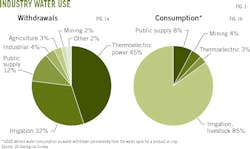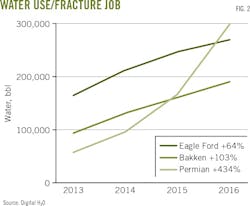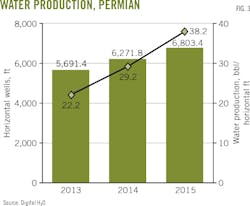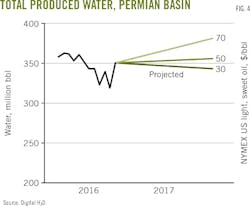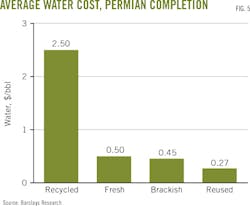Oil and natural gas companies are honing strategies for reducing production costs through effective water-management practices and wastewater disposal options, said a report commissoned by Barclays Research with contributions from Columbia Water Cener.
Alternate water sources such as saline or municipal effluent can preserve fresh water. Barclays' report focused on US oil and gas production, analyzing water-consumption statistics and comparing publicly available information with statistics from Digital H20 and Columbia Water Center as well as its own data.
Evolving regulations and improved data management could encourage oil companies to invest in water infrastructure, enter public-private partnerships, and collaborate with other industries on water-management technology, the report said.1
The US Geological Survey classifies oil and gas as part of the mining industry. Fig. 1a shows mining accounted for 2% of total nationwide freshwater withdrawals in 2010, the latest available statistics.
Only 2.5% of the world's water is fresh water, but the US depends on fresh water for 90% of its public and industrial use.
Oil and gas water consumption varies by operating region. Fig. 1b shows oil and gas water withdrawals are small compared with other industries, but oil and gas operations are becoming increasingly water intensive, the Barclays-Columbia report said.
Growing competition for water will increase future water costs. Some operators might have to decide between investing more in water management or curbing water usage. Produced-water disposal costs also are expected to increase.
Zachary Sadow, Barclays analyst, said the report concludes the oil and gas industry could consume less fresh water and do more to access alternate sources through recycling and reusing more produced wastewater.
The oil-price slump that started in late 2014 has forced producers to cut spending and reduce operating expenses, encouraging more innovative, efficient water management. Sadow expects industry will intensify its focus on water management.
Fracturing
The public considers hydraulic fracturing to be controversial and water intensive. But USGS studies show fracturing uses only a fraction of available US fresh water.
The use of water for fracturing varies by location depending on its availability in any given year and the type of well drilled. Barclays estimates that reusing produced water in fracturing operations could lower industry's water costs by about 45% and save over 300,000 bbl/well of fresh water.
Total US water use has risen since 2008. USGS said median use for hydraulic fracturing injections increased to nearly 128,102 bbl of fresh water/oil well in 2014 from 5,618 bbl in 2008. For gas, water use was 162,906 bbl/well in 2014.2
Vertical and directional wells require less water than horizontal wells. A map of US water use for fracturing during 2000-14 shows shale gas areas had the highest water use.3
Public concern over water constraints could lead to state regulations, potentially affecting the way oil and gas companies handle water and wastewater. Water disposal rules and water acquisition regulations vary by state. Sadow told OGJ that he expects the Permian basin in West Texas and New Mexico will set trends for US shale producers' water management.
Fig. 2 shows increased water use per well during 2013-16 broken down by play for the Permian basin, Williston basin in North Dakota and Montana, and the Eagle Ford in South Texas. The Permian had the biggest increase in fracturing water use of the three plays.
The Permian also has the highest amount of produced water among US oil and gas basins. Fig. 3 shows Permian operators are drilling longer laterals. Fig. 4 shows that produced water volumes per horizontal ft have grown.
The amount of produced water and the water-to-oil ratio influence an operator's water management costs and choices. The Permian basin has the highest water-to-oil ratio among the three major US onshore oil basins, said the joint report.
Digital H2O Inc. of Chicago shared production data and predictive analytics with the Barclays-Columbia researchers. More than 6.5 bbl of water was produced for every 1 bbl of Permian oil produced in 2016. That compares with 1.1 bbl of water produced for every 1 bbl of oil in the Williston basin (Bakken formation), and 0.9 bbl of water in the Eagle Ford, Digital H2O said.
Water costs
Water-related expenses make up 10-30% of a well's capital expenditure, while 40-55% of operating costs come from produced water management and disposal.4
The percentage varies by basin depending upon freshwater availability, competing water uses, water quality, distance from water sources and disposal sites, state and federal regulations, and wastewater treatment methods.
Transportation of fresh water and wastewater remains a high operating cost. The US Energy Information Administration (EIA) estimates water-disposal costs, including trucking and injection, of $1-$8/bbl of water.5
Fig. 5 shows that water costs for Permian basin completions, excluding transportation costs, depend on the type of water used. Produced water volumes will increase when oil prices recover. Renewed well completion activity will increase pressure on available disposal-well capacity, the report said. Sadow said that reusing wastewater not only cuts water acquisition costs but also disposal and transportation costs.
Barclays' report noted Permian operator Pioneer Natural Resources has partnered with the city of Midland, Tex., to use municipal wastewater. Midland officials put out a request for proposals to help finance upgrades to the city treatment plant. The proposal request said the company chosen would benefit from the treated municipal water.
City officials accepted Pioneer's proposal to upgrade the water treatment system for $115 million. Pioneer's Permian operations used 300,000 b/d of water on average for 14 rigs during 2016. Under a contract starting in 2019, Pioneer will pay the city of Midland 29¢/bbl or $2.5 million/year. The net cost to Pioneer will be 6-10¢/bbl of water, 84% less than the regional cost of freshwater.
Separately, Laredo Petroleum of Tulsa has invested $56 million in water infrastructure assets for its Permian operations. The independent set up corridors to move oil and gas to market and water to a centralized water-treatment center.
Laredo estimates the corridors provide $1.3 million in benefits per 10,000-ft horizontal well. The firm estimates its water infrastructure saved it $12.7 million during 2016.
The practice of gathering and transporting produced water by pipe instead of truck displaced 95,000 truckloads of water at a savings of 85¢/bbl of water, Laredo told Barclays-Columbia researchers. The use of recycled water in well completions, meanwhile, saved 26¢/bbl of water compared with Laredo having to buy freshwater. Laredo estimates its production corridors reduced its lease operating expense by 51¢/boe.
Flowback, produced water
Oil and gas producers have several methods for managing wastewater, including injecting it into deep underground wells, recovering some of the oil it contains, and treating for reuse and recycling.
A combination of flowback and produced water rise to the surface along with oil and gas. Flowback is fluid injected into the well that returns to the surface after fracturing. Produced water is naturally occurring water, typically having a high-salt content.
State and federal regulations cover flowback and produced water because both contain oil, radioactive material, chemicals, and dissolved solids such as salt. Flowback and produced water must be treated before disposal.
Both flowback and produced water rise to the surface throughout a well's life. Wastewater's quality determines whether it will be injected, reused, or recycled for use in another industry. Direct reuse of wastewater within a well is the most basic treatment method, requiring little treatment.
Light treatment is sufficient to prepare water for injection into a saltwater disposal well, but more advanced treatment is needed for recycling wastewater for other purposes. Typically, producers transport wastewater to a specialized treatment center.
Sadow said oil and gas companies can be incentivized to increase wastewater recycling and reuse through improved regulatory, data, and technological transparency.
Separate from the report, the Oklahoma Corporation Commission's Oil and Gas Division has issued disposal well restrictions in areas deemed susceptible to earthquakes, shutting down some disposal wells and reducing volumes at others.
Meanwhile, the Texas Water Development Board has been researching brackish water, which industry uses across parts of the Permian basin.6
Sadow said, "New technologies mean brackish water can be used for industrial and oil and gas operations and can even be transformed into drinking water through desalination treatment."
Reuse, recycle
Economics, water availability, water quality logistics, and disposal options dictate whether an operator reuses or recycles. Recycling and reuse rates vary nationwide.
An operator such as Laredo needs enough contiguous acreage to reuse water because wastewater rises to the surface over variable periods. Wastewater sometimes needs to be stored until it can be transported to a new well for reuse. Water storage and transportation runs the risk of toxic wastewater spills.
Industry sometimes uses the terms recycling and reuse interchangeably. Barclays defined reuse as wastewater reused within a well, which requires very little additional treatment. Recycling was defined as treating wastewater to acceptable standards.
Collaboration with other industries, typically agriculture, creates new opportunities for water management. Some oil companies call these collaborations beneficial reuse while other companies call them recycling.
There are many uses for recycled wastewater, especially livestock watering, irrigation, or industrial reuse for crops. Some Midland farmers are experimenting with using recycled water from oil and gas for irrigation on non-food crops such as cotton.7
Chevron Corp. sells treated wastewater to California farmers for irrigation. Some environmental groups oppose the practice, saying researchers have yet to determine if radioactive material or metals in recycled water can harm soil or crops.8
Barclays' report concluded that increased regulatory clarity could help operators increase water reuse. Enhanced industry coordination also will help research drive costs lower.
Once operators substantially increase reuse, Barclays said the next steps for recycling include:
• Improving and reducing their costs, including membranes and distillation. Storage tanks and pits must be designed to prevent spillage.
• Increasing investment around water infrastructure to ensure safe transportation of wastewater to centralized treatment plants and other operators.
• Coordinating research and development between operators, government, and policy groups on the long-term health and environmental effects of using produced water for irrigation and drinking.
References
1. Barclays Research Impact Series #2, "The Water Challenge: Preserving a Global Resource," Mar. 21, 2017.
2. US Geological Survey, "Water Used for Hydraulic Fracturing Varies Widely Across United States," June 30, 2015.
3. Gallegos, T., Varela, B., Haines, S., and Engle, M., "Hydraulic fracturing water use variability in the United States and potential environmental implications," Water Resources Research, Vol. 51, No. 7, Jan. 7, 2015, pp. 5839-45,
4. Digital H2O, "2015 US Onshore Oilfield Water Market Recap and 2016 Water Outlook," Feb. 18, 2016.
5. US Energy Information Administration, "Trends in US Oil and Natural Gas Upstream Costs," March 2016.
6. Texas Water Development Board, "Brackish Resource of Aquifer Characterization System (BRACS)," https://www.twdb.texas.gov/innovativewater/bracs/index.asp.
7. Mulder, B., "Researchers Experiment with Oilfield Wastewater," Midland Reporter-Telegram, Jan. 14, 2016.
8. Mark, J., "Oil and Agriculture Don't Mix," Sierra, Dec. 10, 2015.
WATER GLOSSARY
Fresh water is safe for human consumption, occurring naturally through precipitation and in rivers and some underground sources.
Brackish water is a naturally occurring mixture of fresh and salt water, also known as brine.
Saline occurs naturally in oceans and has a salt content higher than brackish water. It is undrinkable.
Recycled water is treated wastewater available to be reused.
Reused water is wastewater reinjected within an oil or gas well, requiring little or no treatment.
Source: Barclays Research

Paula Dittrick | Senior Staff Writer
Paula Dittrick has covered oil and gas from Houston for more than 20 years. Starting in May 2007, she developed a health, safety, and environment beat for Oil & Gas Journal. Dittrick is familiar with the industry’s financial aspects. She also monitors issues associated with carbon sequestration and renewable energy.
Dittrick joined OGJ in February 2001. Previously, she worked for Dow Jones and United Press International. She began writing about oil and gas as UPI’s West Texas bureau chief during the 1980s. She earned a Bachelor’s of Science degree in journalism from the University of Nebraska in 1974.
